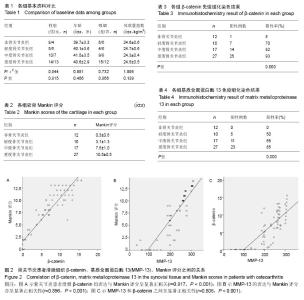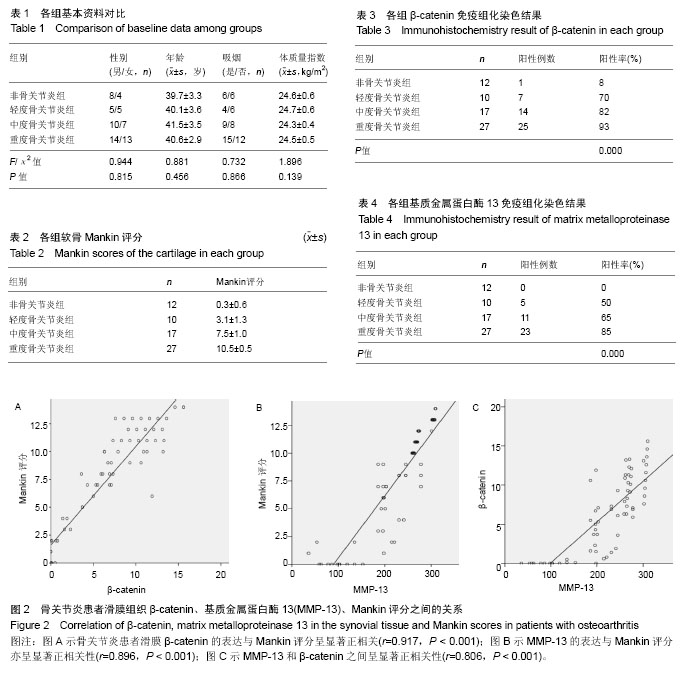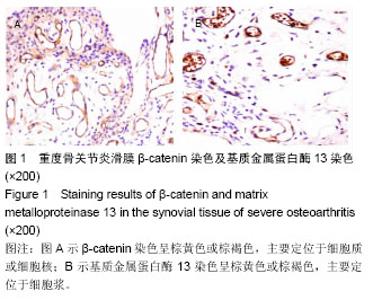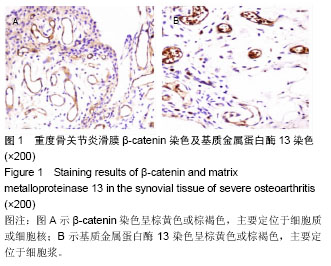| [1] 吕苏梅,张瑞丽.中老年膝骨关节炎的流行病学研究进展[J].中国老年学,2016, 36(16):4133-4135.[2] Cushnaghan J, Dieppe P. Study of 500 patients with limb joint osteoarthritis.I.Analysis by age,sex,and distribution of symptomatic joint sites. Ann Rheum Dis. 1991;51(1):8-13.[3] Adebajo AO.Pattern of osteoarthritis in a West African teaching hospital. Ann Rheum Dis. 1991;50(1):20-22.[4] Spector TD. Epidemiology of the rheumatic diseases.Curr Opin Rheumatol. 1993;5(2): 132-137.[5] 陈临新.膝关节骨关节炎的诊疗[J].中国全科医学,2009,12(2B): 297-298.[6] Hideto W. Aggrecan and its chondroitin sulfate in cartilage. Seikagaku. 2008;80(1):28-32. [7] Mitchell PG, Magna HA, Reeves LM, et al. Cloning, Expression,and typeⅡ Collagenolytic activity of matrix Metalloproteinase13 from human osteoarthritic cartilage. J Clin Invest.1996;97(3):761-768.[8] 包刚,刘永,刘亚丽,等.MMP-13在骨性关节炎滑膜组织中的表达分析[J].中国实验诊断学,2016,20(9):1548-1549.[9] Piecha D, Weik J, Kheil H, et al.Novel selective MMP-13 inhibitors reduce collagen degradation in bovine articular and human osteoarthritis cartilage explants. Inflamm Res. 2010; 59(5):379-389. [10] Yamakawa K, Kamekura S, Kawamura N, et al. Association of microsomal prostaglandin E synthase 1 deficiency with impaired fracture healing,but not with bone loss or osteoarthritis, in mouse models of skeletal disorders. Arthritis Rheum.2008;58(1):172-183.[11] Little CB, Meeker CT, Golub SB, et al.Blocking aggrecanase cleavage in the aggrecan interglobular domain abrogates cartilage erosion and promotes cartilage repair. J Clin Invest. 2007;117(6):1627-1636. [12] Johnson ML, Kamel MA. The Wnt signaling pathway and bone metabolism. Curr Opin Rheumatol. 2007;19(4):376-382.[13] Cox RT, Peifer M. Wingless signaling:the inconvenient complexities of life. Curr Biol. 1998;8(4):R140-144. [14] 郭晓兰,周京国,袁国华.尿激酶型纤溶酶原激活物受体与炎性关节病[J].国际内科学杂志, 2005,32(3):123-125.[15] Olkku A, Mahonen A. Calreticulin mediated glucocorticoid receptor export is involved in beta-catenin translocation and Wnt signalling inhibition in human osteoblastic cells. Bone. 2009;44(4):555-565.[16] 中华医学会.骨关节炎诊治指南(2007年版)[J].中国矫形外科杂志,2014,22(3):287-288.[17] Kuryliszyn-Moskal A. Comparison of blood and synovial fluid lymphocyte subsets in rheumatoid arthritis and osteoarthritis. Clin Rheumatol. 1995;14(1):43-50.[18] 许鹏,王效东,郭雄.透明质酸与骨关节炎[J].中华风湿病学杂志, 2002,6(5):360-363.[19] Bedine PV,Stauffer B,Ponce-de-Leon H,et al. A small molecule inhibitor of the wnt antagonist secreted frizzled-related protein-1stimulates bone formation. Bone. 2009;44(6):1063-1068.[20] Frank PL,Przemko T,Rik JL.Wnt signaling and osteoarthritis. Bone. 2009;44(4):522-527.[21] Zhu M,Tang D,Wu Q,et al.Activation of beta-catenin signaling in articular chondrocytes leads to osteoarthritis like phenotype in adult beta-catenin conditional activation mice. Bone Miner Res. 2009;24(1):12-21.[22] Papathanasiou I,Malizos KN,Tsezou A.Low-density lipoprotein receptor-related protein5(LRP5) expression in human osteoarthritic chondrocytes. J Orthp Res. 2010;28(3): 348-353.[23] Daugherty RL,Gottardi CJ.Phospho-regulation of Beta-catenin adhesion and signaling functions.Physiology (Bethesda). 2007;22(5):303-309. |



